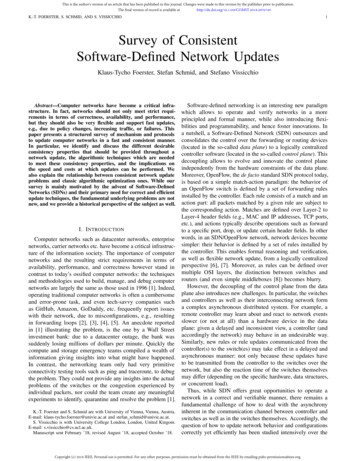
Transcription
This is the author's version of an article that has been published in this journal. Changes were made to this version by the publisher prior to publication.The final version of record is available . FOERSTER, S. SCHMID, AND S. VISSICCHIO1Survey of ConsistentSoftware-Defined Network UpdatesKlaus-Tycho Foerster, Stefan Schmid, and Stefano VissicchioSoftware-defined networking is an interesting new paradigmwhich allows to operate and verify networks in a moreprincipled and formal manner, while also introducing flexibilities and programmability, and hence foster innovations. Ina nutshell, a Software-Defined Network (SDN) outsources andconsolidates the control over the forwarding or routing devices(located in the so-called data plane) to a logically centralizedcontroller software (located in the so-called control plane). Thisdecoupling allows to evolve and innovate the control planeindependently from the hardware constraints of the data plane.Moreover, OpenFlow, the de facto standard SDN protocol today,is based on a simple match-action paradigm: the behavior ofan OpenFlow switch is defined by a set of forwarding rulesinstalled by the controller. Each rule consists of a match and anaction part: all packets matched by a given rule are subject tothe corresponding action. Matches are defined over Layer-2 toLayer-4 header fields (e.g., MAC and IP addresses, TCP ports,etc.), and actions typically describe operations such as forwardI. I NTRODUCTIONto a specific port, drop, or update certain header fields. In otherwords,in an SDN/OpenFlow network, network devices becomeComputer networks such as datacenter networks, enterprisesimpler:their behavior is defined by a set of rules installed bynetworks, carrier networks etc. have become a critical infrastructhecontroller.This enables formal reasoning and verification,ture of the information society. The importance of computeraswellasflexiblenetwork update, from a logically centralizednetworks and the resulting strict requirements in terms ofperspective[6],[7].Moreover, as rules can be defined overavailability, performance, and correctness however stand inmultipleOSIlayers,the distinction between switches andcontrast to today’s ossified computer networks: the techniquesrouters(andevensimplemiddleboxes [8]) becomes blurry.and methodologies used to build, manage, and debug computerHowever,thedecouplingof the control plane from the datanetworks are largely the same as those used in 1996 [1]. Indeed,planealsointroducesnewchallenges.In particular, the switchesoperating traditional computer networks is often a ngnetwork formand error-prone task, and even tech-savvy companies le, aas GitHub, Amazon, GoDaddy, etc. frequently report rkeventswith their network, due to misconfigurations, e.g., edatain forwarding loops [2], [3], [4], [5]. An anecdote ntroller(andin [1] illustrating the problem, is the one by a Wall Streetinvestment bank: due to a datacenter outage, the bank was accordingly the network) may behave in an undesirable way.suddenly losing millions of dollars per minute. Quickly the Similarly, new rules or rule updates communicated from thecompute and storage emergency teams compiled a wealth of controller(s) to the switch(es) may take effect in a delayed andinformation giving insights into what might have happened. asynchronous manner: not only because these updates haveIn contrast, the networking team only had very primitive to be transmitted from the controller to the switches over theconnectivity testing tools such as ping and traceroute, to debug network, but also the reaction time of the switches themselvesthe problem. They could not provide any insights into the actual may differ (depending on the specific hardware, data structures,problems of the switches or the congestion experienced by or concurrent load).Thus, while SDN offers great opportunities to operate aindividual packets, nor could the team create any meaningfulnetworkin a correct and verifiable manner, there remains aexperiments to identify, quarantine and resolve the problem [1].fundamental challenge of how to deal with the asynchronyK.-T. Foerster and S. Schmid are with University of Vienna, Vienna, Austria. inherent in the communication channel between controller andE-mail: klaus-tycho.foerster@univie.ac.at and stefan schmid@univie.ac.at.switches as well as in the switches themselves. Accordingly, theS. Vissicchio is with University College London, London, United Kingom.question of how to update network behavior and configurationsE-mail: s.vissicchio@cs.ucl.ac.uk.Manuscript sent February ’18, revised August ’18, accepted October ’18.correctly yet efficiently has been studied intensively over theAbstract—Computer networks have become a critical infrastructure. In fact, networks should not only meet strict requirements in terms of correctness, availability, and performance,but they should also be very flexible and support fast updates,e.g., due to policy changes, increasing traffic, or failures. Thispaper presents a structured survey of mechanism and protocolsto update computer networks in a fast and consistent manner.In particular, we identify and discuss the different desirableconsistency properties that should be provided throughout anetwork update, the algorithmic techniques which are neededto meet these consistency properties, and the implications onthe speed and costs at which updates can be performed. Wealso explain the relationship between consistent network updateproblems and classic algorithmic optimization ones. While oursurvey is mainly motivated by the advent of Software-DefinedNetworks (SDNs) and their primary need for correct and efficientupdate techniques, the fundamental underlying problems are notnew, and we provide a historical perspective of the subject as well.Copyright (c) 2018 IEEE. Personal use is permitted. For any other purposes, permission must be obtained from the IEEE by emailing pubs-permissions@ieee.org.
This is the author's version of an article that has been published in this journal. Changes were made to this version by the publisher prior to publication.The final version of record is available . FOERSTER, S. SCHMID, AND S. VISSICCHIO2last years. However, the notions of correctness and efficiency2) Maintaining consistency: It is often desirable that thesignificantly differ across the literature. Indeed, what kind network maintains certain consistency properties throughoutof correctness is needed and which performance aspects are the update. Those properties may include per-packet pathmost critical often depends on the context: in security-critical consistency (a packet should be forwarded along the old or thenetworks, a very strong notion of correctness may be needed, new route, but never a mixture of both), waypoint enforcementeven if it comes at a high performance cost; in other situations, (a packet should never bypass a firewall), or at least correcthowever, short transient inconsistencies may be acceptable, as packet delivery (at no point in time packets should be droppedlong as at least some more basic consistency guarantees are or trapped in a loop).3) Towards SDNs: While the above reasons for networkprovided (e.g., loop-freedom).updatesare relevant independently of the adopted paradigm, theWe observe that not only is the number of research resultsdecouplingof control- and data-plane, as well as the flexibilityin the area growing very quickly, but also the number ofallowedbythe SDN architecture are likely to increase themodels, the different notions of consistency and optimizationfrequencyofnetwork updates, e.g., for supporting more fineobjectives, as well as the algorithmic techniques: Thus, it hasgrainedandfrequentoptimization of traffic paths [9].become difficult to keep an overview of the field even for activeresearchers. Moreover, many of the underlying update problemsare not entirely new or specific to SDN: rather, techniques to B. Our ContributionsThis paper presents a comprehensive survey of the consistentconsistently update legacy networks have been studied in thenetworkupdate problem in Software-Defined Networks (SDNs).literature, although they are based on the (more restrictive)Inthebasicscenario assumed by most prior contributions,primitives available in traditional protocols (e.g., IGP weights).anSDNnetworkis controlled by a single controller, whichWe therefore believe that it is time for a comprehensiveneedstopreservespecific consistency properties at each andsurvey of the subject.every moment during the update. Preserving such propertiesis often argued to be more important that the induced inability to guarantee perfect network availability or partitionA. The Network Update Problemtolerance simultaneously—e.g., to avoid packet losses orAny dependable network does not only need to maintain security breaches. This impossibility result follows from thecertain invariants, related to correctness, availability, and perfor- celebrated CAP theorem [10], which also applies to controlmance, but also needs to be flexible in how it process packets. algorithms used in networks [11]. Throughout this paper, we1) Flexibility: Flexibility implies that networks have to be first consider this basic scenario and then extend the discussionto network updates with distributed SDN controllers andupdated, e.g., to support the following use cases.a) Security policy changes: For example, in enterprise different consistency models [12], [13], [14]. The goal ofnetworks, traffic from a specific subnetwork may have to be our survey is to both (1) provide active researchers in the fieldrouted via a firewall if specific alarms are raised. Similarly, with an overview of the state-of-the-art literature, and (2) helpin wide-area networks, the countries that must be avoided by researchers who only recently became interested in the subjectbootstrap and learn about open research questions.sensitive traffic can change over time.In discussing the literature, we identify and compare theb) Traffic engineering: To improve performance metricsconsistency properties (absence of forwarding loops and(e.g., minimizing the maximal link load), a network operatorblackholes, policy preservation, congestion avoidance, etc.)may decide to reroute some traffic to different paths. Forand performance objectives (update duration, maximum linkexample, many Internet Service Providers change their pathsoverload during the update, etc.) considered by the scientificduring the day, depending on the expected load or in reactionliterature. We provide an overview of the algorithmic techniquesto external changes (e.g., a policy modification from a contentrequired to solve specific classes of network update problems,provider).and discuss the inherent tradeoffs between the achievable levelc) Maintenance work: Also maintenance work may of consistency and the speed at which networks can be updated.require the update of network routes. For example, in order to In fact, as we will see, some update techniques are not only lessreplace a faulty router, or to upgrade an existing router, it can efficient than others, but with them, it can even be impossiblebe necessary to temporarily reroute traffic.to consistently update a network.d) Link and node failures: Failures happen quite freWe also present a historical perspective, surveying thequently and unexpectedly in today’s computer networks, and consistency notions provided in traditional networks andtypically require a fast reaction. Accordingly, fast network discussing the corresponding techniques accordingly.monitoring and update mechanisms are required to react toMoreover, we put the algorithmic problems into perspectivesuch failures, e.g., by determining a failover path.and discuss how these problems relate to classic optimizatione) Service relocation: Networks typically run several and graph theory problems, such as multi-commodity flowservices, from in-network packet processing functions (e.g., problems or maximum acyclic subgraph problems.virtualized middleboxes) to applications (like data storage orapplication servers). Addition, removal or relocation of any of C. Paper Organizationthose services would require a network update, i.e., to rerouteThe remainder of this paper is organized as follows. §IItraffic for the affected service.presents a historical perspective and reviews notions of con-Copyright (c) 2018 IEEE. Personal use is permitted. For any other purposes, permission must be obtained from the IEEE by emailing pubs-permissions@ieee.org.
This is the author's version of an article that has been published in this journal. Changes were made to this version by the publisher prior to publication.The final version of record is available . FOERSTER, S. SCHMID, AND S. VISSICCHIOsistency and techniques both in traditional computer networksas well as in Software-Defined Networks. §III then presentsa classification and taxonomy of the different variants of theconsistent network update problems. §IV, §V, and §VI reviewmodels and techniques for connectivity consistency, policyconsistency, and capacity consistency related problems, respectively. §VII-A discusses proposals to further relax consistencyguarantees by introducing tighter synchronization. In §VIII, weidentify practical challenges. After highlighting future researchdirections in §IX, we conclude our paper in §X.3forwarding changes to be applied for a generic network update.Observe that possible forwarding loops can occur when weupdate nodes one by one, because links (v1, v2) and (v2, v3)are traversed in opposite directions before and after the u
This paper presents a comprehensive survey of the consistent network update problem in Software-Defined Networks (SDNs). In the basic scenario assumed by most prior contributions, an SDN network is controlled by a single controller, which needs to preserve specific consistency properties at each and every moment during the update. Preserving such properties











